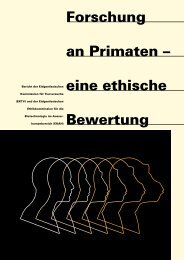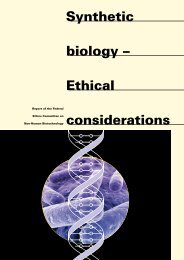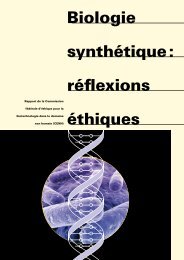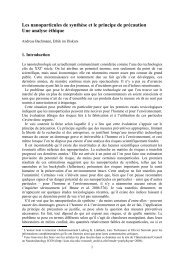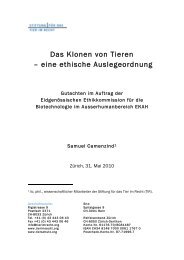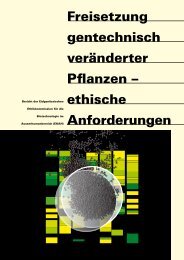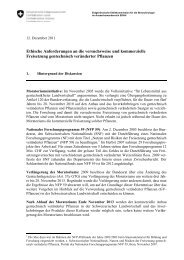Helmut Segner Fish Nociception and pain A biological perspective
Helmut Segner Fish Nociception and pain A ... - EKAH - admin.ch
Helmut Segner Fish Nociception and pain A ... - EKAH - admin.ch
- No tags were found...
You also want an ePaper? Increase the reach of your titles
YUMPU automatically turns print PDFs into web optimized ePapers that Google loves.
3.2.2 Neuroanatomical correlates of <strong>pain</strong> perception<br />
Pain perception in man has its neural correlate in the <strong>pain</strong> matrix<br />
which comprises brain stem, thalamus, subcortical as well as neocortical<br />
areas. While the neocortex is absent in teloest fish, the<br />
brainstem regions <strong>and</strong> the thalamus are present. The situation is<br />
less clear with respect to the subcortical components of the <strong>pain</strong><br />
matrix which have their origin in the telencephalon such as amygdala<br />
<strong>and</strong> hippocampus. Earlier theories on the evolution of the<br />
cerebrum in vertebrates held that new regions gradually emerged<br />
out of pre-existing regions (Kardong 2006). Along this line, the<br />
neocortex was understood as a “neostructure” which evolutionary<br />
developed from a pallial archistructure. Meanwhile, a revised view<br />
of cerebral evolution in vertebrates is established which underst<strong>and</strong>s<br />
the evolution of the vertebrate forebrain not as a stepwise,<br />
linear process, but as a divergent differentiation from a common<br />
ancestral anatomy. That basal structure of the vertebrate cerebrum<br />
comprises a pallium with medial, dorsal <strong>and</strong> lateral divisions, <strong>and</strong><br />
a subpallium with striatum, septum <strong>and</strong> pallidum (Northcutt 1995,<br />
Kardong 2006, Medina <strong>and</strong> Abellan 2009). In teleosts, the pallium<br />
(but not the subpallium) becomes everted <strong>and</strong> swings outward<br />
involving re-arrangement of pallial areas (Northcutt 2008), while<br />
in all other vertebrates, it becomes inverted, with the medial pallium<br />
<strong>and</strong> septum rolling inward <strong>and</strong> the lateral <strong>and</strong> dorsal walls<br />
inverting outward (Figure 8). Compared to the brains of the other<br />
vertebrates, the fish pallium, therefore, can be considered to be<br />
inside-out.<br />
Among the tetrapods, the pallial (cortical) regions undergo diverse<br />
evolutionary developments, which involve not only an increase<br />
in size but also a thickening <strong>and</strong> differentiation into layers. In reptiles,<br />
the lateral pallium gets hypertrophied <strong>and</strong> develops into the<br />
dorsal ventricular ridge which dominates the cerebral hemispheres.<br />
In birds, this dorsal ventricular ridge exp<strong>and</strong>s further <strong>and</strong> forms the<br />
so called Wulst, a region that has a high capacity for processing of<br />
visual information. In mammals, it is the dorsal pallium that experiences<br />
a tremendous evolution <strong>and</strong> gives rise to the neocortex. The<br />
medial pallium, together with parts of the lateral pallium forms the<br />
hippocampus of tetrapods. The subpallium contributes to basal<br />
ganglia, caudate nucleus, putamen <strong>and</strong> amygdale of tetrapods.<br />
Evagination<br />
Neutral<br />
tube<br />
Eversion<br />
P1<br />
P2<br />
P3<br />
Figure 8: Development of the pallium<br />
in actinopterygian vertebrates<br />
(fin-rayed fish, including teleosts)<br />
<strong>and</strong> in non-actinopterygian<br />
vertebrates (including tetrapods).<br />
In teleosts, the pallium (but not the<br />
subpallium) becomes everted <strong>and</strong><br />
swings outward involving rearrangement<br />
of pallial areas (Northcutt<br />
2008), while in the other vertebrates,<br />
it becomes inverted, with the<br />
medial pallium <strong>and</strong> septum rolling<br />
inward <strong>and</strong> the lateral <strong>and</strong> dorsal<br />
walls inverting outward. These<br />
differences complicate the recognition<br />
of homologies.<br />
P1, P2, <strong>and</strong> P3 correspond to the three<br />
main subdivisions of the pallium.<br />
(Modified from Broglio et al., 2003)<br />
Non-Actinopterygians<br />
Actinopterygians<br />
1. Dorsal pallium<br />
2. Lateral pallium<br />
3. Medial pallium<br />
4. Septum<br />
5. Striatum<br />
6. Accumbens<br />
7. Area dorsalis telencephali<br />
pars dorsalis<br />
8. Area dorsalis telencephali<br />
pars medialis<br />
9. Area dorsalis telencephali<br />
lateralis pars dorsalis<br />
10. Area dorsalis telenecephali<br />
pars centralis<br />
11. Area ventralis telenecephali<br />
pars dorsalis<br />
12. Area dorsalis telencephali<br />
lateralis pars ventralis<br />
13. Area ventralis telenecephali<br />
pars ventralis<br />
38 <strong>Fish</strong>. <strong>Nociception</strong> <strong>and</strong> <strong>pain</strong> | Contributions to Ethics <strong>and</strong> Biotechnology<br />
<strong>Fish</strong>. <strong>Nociception</strong> <strong>and</strong> <strong>pain</strong> | Contributions to Ethics <strong>and</strong> Biotechnology<br />
39



